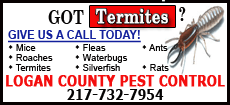|
Weeds and weed control
By Jennifer
Fishburn, horticulture educator, University of
Illinois Extension
 Send a link to a friend
Send a link to a friend
[July
03, 2013]
This weekend, in between the
rain showers, I finally had the opportunity to tend to my flower
beds. While not the most enjoyable outdoor task, weeding is
necessary. Remember the saying, "One year of seeds equals seven
years of weeds." That is enough motivation for me to pull weeds in
this heat, humidity and mud.
|
 A weed is defined as "a plant out of place." Weeds compete with
desirable plants for light, nutrients, space and water. Weeds
also harbor insects (mosquitoes) and diseases. It is critical,
especially at this time of year, to control weeds in the garden. A weed is defined as "a plant out of place." Weeds compete with
desirable plants for light, nutrients, space and water. Weeds
also harbor insects (mosquitoes) and diseases. It is critical,
especially at this time of year, to control weeds in the garden.
There are many weeds that develop at this time of year. Some
of the kinds I had the pleasure of pulling were smartweed,
lamb's-quarters, foxtail and red root pigweed. What gardeners
dread and these weeds have in common are that they grow rapidly,
flower quickly and produce thousands of seeds.
Proper identification of a weed and understanding its growth
cycle are necessary to its control. It is helpful to know if the
weed is an annual, biennial or perennial. Annual weeds, which
include crabgrass, smartweed, foxtail, buttonweed and
lamb's-quarters, come back from seed each year. Biennial weeds
live two years, producing seed the second year. Burdock is one
example of a biennial weed. Perennial weeds come back year after
year from the same root. Dandelions, quack grass and creeping
Charlie are dreaded examples of perennial weeds.

Weed control options include mulching, herbicides and the
not-so-favorite hand pulling.
Mulch. Mulching is my favorite option for weed control.
Mulches help to suppress seed germination, conserve soil
moisture and keep the soil temperature more even. In vegetable
gardens, mulch keeps the fruits off the ground. Most plants will
benefit from a 2- to 3-inch layer of mulch applied around the
plant. To avoid crown rot, keep mulch away from the base of a
plant. Mulches control weeds by preventing light, which is
needed for germination, from reaching the soil surface. Mulches
can be organic or inorganic. Organic mulches include compost,
shredded leaves, wood chips, dry grass clippings, newspaper and
pine needles. Inorganic mulches include fabric weed barrier,
black plastic and rock.
Ground covers. Bare patches of soil will invite weed seed
germination, especially in sunny spots. To prevent weeds from
taking over a bare soil area, plant a ground cover such as hosta
or vinca in a shady area or a thyme or low-growing sedum in full
sun.
[to top of second column] |

Hand removal. This method of weed removal includes hoeing,
tilling, mowing and hand pulling with a tool such as a garden knife.
Cut off weeds just below the soil surface with a sharp hoe.
Desirable plants roots are just below the soil surface and can be
easily damaged. Ideal between vegetable garden rows (provided you
have left ample space between rows) is shallow cultivation with a
rotary tiller or manual-powered rotary cultivator. One rule of
thumb: Weeds are easiest to remove when the soil is moist but not
muddy. Hand removal is easy if you start when the weeds are small
and tackle one small area at a time.
Herbicides. Pre-emergent herbicides keep the seed from
emerging through the soil. A common pre-emergent herbicide for the
home garden is trifluralin, sold as Preen. Post-emergent herbicides
control a weed after it has emerged from the soil. Glyphosate, sold
as Roundup or Kleenup, is a nonselective herbicide for controlling
perennial weeds. Nonselective means it will kill any plant. To
protect your desirable plants, use a foam paintbrush to apply the
glyphosate. Herbicide usage is not recommended in vegetable gardens.
When using any chemical, it is important to read and follow all
label directions. And pay attention to the appropriate time to apply
the chemical, or you have wasted your time and money.
For more information on weed identification and control of common
weeds, visit University of Illinois searchable websites at
http://weeds.cropsci.illinois.edu/weedid.htm.
[By JENNIFER FISHBURN, horticulture
educator,
University of Illinois Extension, Logan-Menard-Sangamon Unit]
 |